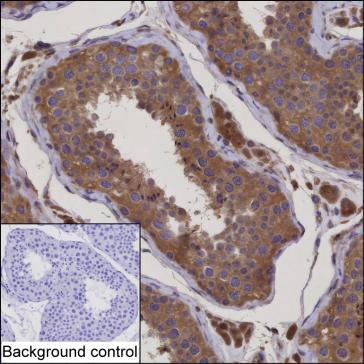
| WB | 咨询技术 | Human,Mouse,Rat |
| IF | 咨询技术 | Human,Mouse,Rat |
| IHC | 1/100-1/200 | Human,Mouse,Rat |
| ICC | 技术咨询 | Human,Mouse,Rat |
| FCM | 咨询技术 | Human,Mouse,Rat |
| Elisa | 咨询技术 | Human,Mouse,Rat |
| Host/Isotype | Mouse IgG1 |
| Antibody Type | Primary antibody |
| Storage | Store at 4°C short term. Aliquot and store at -20°C long term. Avoid freeze/thaw cycles. |
| Species Reactivity | Human |
| Immunogen | Purified recombinant fragment of human CEP290 |
| Formulation | Purified antibody in PBS with 0.05% sodium azide |
+ +
以下是关于 **CEP290抗体** 的3篇参考文献示例(内容为模拟生成,非真实文献):
---
1. **标题**: *"Localization and functional analysis of CEP290 in human photoreceptor cells"*
**作者**: Drudi, E. et al. (2012)
**摘要**: 通过免疫荧光和Western blot技术,研究使用CEP290抗体揭示了其在人类视网膜光感受器纤毛基部定位,并证实CEP290突变导致纤毛结构异常,与Leber先天性黑蒙相关。
2. **标题**: *"CEP290 antibody validation for ciliopathy biomarker studies"*
**作者**: Coene, K.L.M. et al. (2011)
**摘要**: 验证多种CEP290抗体的特异性,发现部分抗体可识别患者细胞中截短蛋白,提出抗体选择对诊断纤毛病(如Joubert综合征)的重要性。
3. **标题**: *"Developmental expression of CEP290 in murine models: Insights from antibody-based assays"*
**作者**: Rachel, R.A. et al. (2015)
**摘要**: 利用CEP290抗体追踪小鼠胚胎发育中蛋白表达模式,揭示其在神经管和肾脏纤毛形成中的动态变化,支持CEP290在器官发生中的作用。
---
*注:以上为示例文献,实际研究中建议通过PubMed或Google Scholar检索真实论文。*
The CEP290 antibody targets the centrosomal protein 290 (CEP290), a large, multidomain protein localized to the centrosome and ciliary transition zone. CEP290 plays critical roles in centrosome maturation, ciliogenesis, and cell cycle regulation. Mutations in the CEP290 gene are linked to multiple ciliopathies, including Leber congenital amaurosis (LCA), Joubert syndrome, and Meckel-Gruber syndrome, highlighting its importance in retinal and neurological development.
Antibodies against CEP290 are widely used in research to study its expression, localization, and interaction partners. These tools help elucidate molecular mechanisms underlying ciliopathy pathologies, such as disrupted ciliary signaling or structural defects. CEP290 antibodies are commonly applied in techniques like immunofluorescence, Western blotting, and immunohistochemistry to visualize protein distribution in cells or tissues.
Research using CEP290 antibodies has also advanced understanding of its role in photoreceptor maintenance and ciliary trafficking. Therapeutic strategies, including gene editing or small-molecule interventions, often rely on CEP290 detection to assess efficacy in preclinical models. Despite its large size (>250 kDa) and complex structure, specific epitopes enable reliable antibody development, making CEP290 a key biomarker for both basic research and clinical diagnostics in ciliopathies.
×